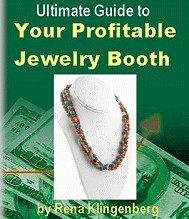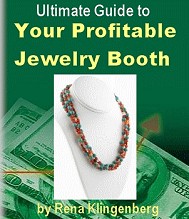Selling Your Jewelry
Making Wire Jewelry is a fabulous pursuit. Learning to acquire new skills offers constant challenge and the opportunity to continually raise the bar on yourself and your designs and abilities. I've always felt lucky to be an artist for many reasons not the least of which is that I'm rarely bored and rather, constantly inspired.
Whether you're an artist or a hobbyist, making wire jewelry can get under your skin as you find more and more inspiration in books or all around you. As you increase your skills, your confidence in both your design and technical skills elevate. Maybe your friends and relatives start asking you to make some pieces for them and suddenly, you're making your first commissioned jewelry. Or maybe you've been a professional art jeweler whose been selling their work from the get go. In either case, the issue of selling your work is on your plate and you either need to learn the basics of where to start or you could be looking for other avenues to sell your work.
As this website has experienced more and more traffic, it's become clear to me that books on selling jewelry are sort of the natural next step for those enjoying or using this site. Today there are several avenues one can use to sell their jewelry pieces. Since some of these ways can be expensive, it is necessary to research any jewelry sales avenue before you jump in. You want to present yourself as professional without losing money if at all possible.
Doing your homework first can help you achieve that.
In the next few weeks, I'll be presenting some books to you on selling your jewelry. The first will be: Ultimate Guide To Your Profitable Jewelry Booth.
Whether you're an artist or a hobbyist, making wire jewelry can get under your skin as you find more and more inspiration in books or all around you. As you increase your skills, your confidence in both your design and technical skills elevate. Maybe your friends and relatives start asking you to make some pieces for them and suddenly, you're making your first commissioned jewelry. Or maybe you've been a professional art jeweler whose been selling their work from the get go. In either case, the issue of selling your work is on your plate and you either need to learn the basics of where to start or you could be looking for other avenues to sell your work.
As this website has experienced more and more traffic, it's become clear to me that books on selling jewelry are sort of the natural next step for those enjoying or using this site. Today there are several avenues one can use to sell their jewelry pieces. Since some of these ways can be expensive, it is necessary to research any jewelry sales avenue before you jump in. You want to present yourself as professional without losing money if at all possible.
Doing your homework first can help you achieve that.
In the next few weeks, I'll be presenting some books to you on selling your jewelry. The first will be: Ultimate Guide To Your Profitable Jewelry Booth.
The Ultimate Guide To Your Profitable Jewelry Booth

Rena Klingenberg has taken the time to share her detailed knowledge about choosing to sell your work at art fairs in "The Ultimate Guide To Your Profitable Jewelry Booth". She covers everything from show preparation, pricing, jurying, marketing and the ever critical information on how your display booth should look.
Having done alot of art fairs early on in my career, I have to admit that selling at fairs, both wholesale and retail was excellent for me. I made quite a good income and starting representing other art jewelers in my booths as well. Having said that, it can be an excellent asset having a resource guide like Rena's on hand especially if selling at shows and fairs is new to you.
There are things you need to know before you jump feet first into this method of selling your precious works. Most of all, you want to learn as much as you can to ensure that you do this in a profitable way and not lose money. I've known far too many beginner art jewelers (with wonderful jewelry, by the way) who have not done their homework, tried their first fair, and failed, losing money. Why? They choose the wrong fair for their price points.
I'll give you an example: Last year, my children's elementary school asked me to participate in their fundraising art fair and assured me that it was a very high quality, juried show and that it would be very well attended. I haven't done an art fair in many years but agreed because I wanted to test some new wire jewelry pieces that were similar to pieces that had sold out in the fine art galleries I was in. I also wanted to support my kid's school. I KNEW I shouldn't do this fair because it was a brand new fair and I never do brand new street fairs. I only ever did wholesale trade shows or very established fine art street fairs that were well established.
In any event, I spent alot of time decorating a gorgeous booth (I totally enjoy that part) and prepared myself for potentially brisk sales. Well, the fair, indeed, was very well attended but in their newness, the organizing committee for the fair faced my booth and several other booths FACING AWAY from the fair's traffic. Back to back with the booths facing the traffic. So traffic on my side of the fair was minimal. As if that weren't bad enough, contrary to what the fair organizers told me, my booth was situated between two other jewelry vendors that were selling seashell and name writing jewelry at $20-$30 each. My lowest price was $50 for earrings because my work is all hand woven, time consuming and made of fine silver. While I sold a handful of earrings, the fair itself cost me money and while my booth was pretty active with oohs and ahhhs (good for my ego instead of my pocketbook) it ended up being just another learning experience and not a profitable one.
My prices and work was too fine and too expensive for that newbie fair. AND I did it against my better instincts knowing from experience that newbie fair promoters make alot of mistakes the first time round.
All of this is to underscore the need for research prior to signing up for any shows and fairs. Attend a fair first, get a feel for it, see if your work fits in, if your prices fit in and then read as much as you can before committing.
The Ultimate Guide To Your Profitable Jewelry Booth can really help you avoid mistakes like the one I made. CLICK HERE to see if this ebook might be something beneficial for you.
Having done alot of art fairs early on in my career, I have to admit that selling at fairs, both wholesale and retail was excellent for me. I made quite a good income and starting representing other art jewelers in my booths as well. Having said that, it can be an excellent asset having a resource guide like Rena's on hand especially if selling at shows and fairs is new to you.
There are things you need to know before you jump feet first into this method of selling your precious works. Most of all, you want to learn as much as you can to ensure that you do this in a profitable way and not lose money. I've known far too many beginner art jewelers (with wonderful jewelry, by the way) who have not done their homework, tried their first fair, and failed, losing money. Why? They choose the wrong fair for their price points.
I'll give you an example: Last year, my children's elementary school asked me to participate in their fundraising art fair and assured me that it was a very high quality, juried show and that it would be very well attended. I haven't done an art fair in many years but agreed because I wanted to test some new wire jewelry pieces that were similar to pieces that had sold out in the fine art galleries I was in. I also wanted to support my kid's school. I KNEW I shouldn't do this fair because it was a brand new fair and I never do brand new street fairs. I only ever did wholesale trade shows or very established fine art street fairs that were well established.
In any event, I spent alot of time decorating a gorgeous booth (I totally enjoy that part) and prepared myself for potentially brisk sales. Well, the fair, indeed, was very well attended but in their newness, the organizing committee for the fair faced my booth and several other booths FACING AWAY from the fair's traffic. Back to back with the booths facing the traffic. So traffic on my side of the fair was minimal. As if that weren't bad enough, contrary to what the fair organizers told me, my booth was situated between two other jewelry vendors that were selling seashell and name writing jewelry at $20-$30 each. My lowest price was $50 for earrings because my work is all hand woven, time consuming and made of fine silver. While I sold a handful of earrings, the fair itself cost me money and while my booth was pretty active with oohs and ahhhs (good for my ego instead of my pocketbook) it ended up being just another learning experience and not a profitable one.
My prices and work was too fine and too expensive for that newbie fair. AND I did it against my better instincts knowing from experience that newbie fair promoters make alot of mistakes the first time round.
All of this is to underscore the need for research prior to signing up for any shows and fairs. Attend a fair first, get a feel for it, see if your work fits in, if your prices fit in and then read as much as you can before committing.
The Ultimate Guide To Your Profitable Jewelry Booth can really help you avoid mistakes like the one I made. CLICK HERE to see if this ebook might be something beneficial for you.

